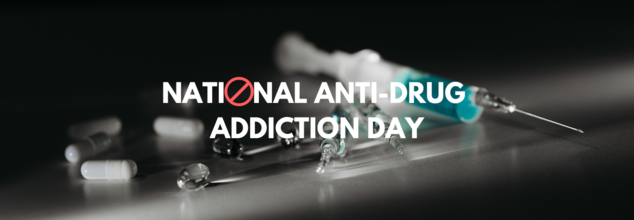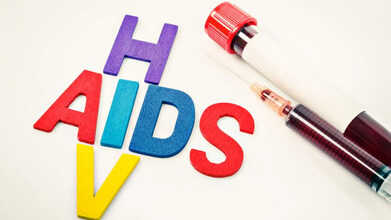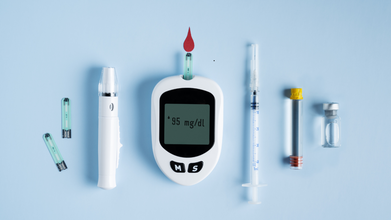- Health Conditions A-Z
- Health & Wellness
- Nutrition
- Fitness
- Health News
- Ayurveda
- Videos
- Medicine A-Z
- Parenting
National Anti-Drug Addiction Day 2024: Reintegrating In Society After Rehab

Credits: Canva
On National Anti-Drug Addiction Day, it's crucial to highlight the growing challenge of substance abuse in India. In India, commonly used and easily accessible drugs include cannabis (bhang, ganja, charas), heroin (chitta), opium, prescription drugs (painkillers, sedatives), alcohol, tobacco, etc.
There is a devastating impact of heroin, commonly referred to as 'chitta' in regions like Punjab and Jammu. It's often sold at affordable prices, making it readily accessible to vulnerable populations, including young adults and adolescents. The ease with which drugs like 'chitta' are accessible has created an alarming addiction crisis, affecting countless individuals and their families.
Recovery from drug addiction is a monumental achievement, but the battle doesn’t end with the completion of a rehab program. The post-recovery phase is often the most challenging. Returning home to environments where drugs like 'chitta' are easily available poses a significant risk of relapse.
So, how can someone who has completed a drug abuse recovery program thrive in such high-risk settings?
Building Resilience Through Mental Health Support
Substance abuse recovery is a complex and often arduous journey that involves much more than just overcoming physical dependence on drugs or alcohol. While detoxification and physical rehabilitation are critical first steps, sustaining long-term sobriety requires addressing the profound mental and emotional impacts of addiction since substance abuse and mental health are deeply interconnected. Many individuals who struggle with addiction may also face underlying mental health conditions such as anxiety, depression, post-traumatic stress disorder (PTSD), etc.
The psychological impact of addiction can leave an individual vulnerable to anxiety, depression, and other mental health challenges. Regular therapy and counselling can help them manage their emotions and reduce the temptation to relapse. Cognitive Behavioral Therapy (CBT) and Dialectical Behavior Therapy (DBT) are especially effective in helping individuals cope with cravings and triggers.
This is why, rehabilitation centres ensure post-recovery follow-up sessions for continued psychological support and post-recovery assistance.
Addressing Trauma
Many individuals who struggle with addiction may have experienced trauma, whether it’s childhood abuse, violence, or other significant emotional upheavals. Unresolved trauma can act as a persistent emotional burden, driving individuals toward substance use as a way to numb their pain. By addressing the root causes of trauma through therapy, individuals can begin to heal and move forward in their recovery journey with a sense of closure and emotional freedom.
Practicing Mindfulness and Stress Management
Stress is a major trigger for relapse, especially in environments where drugs are easily accessible. Emotions like stress, anxiety, sadness, and anger can all serve as powerful triggers for substance use. Incorporating mindfulness practices like meditation, yoga, and breathing exercises can help recovering individuals manage stress and anxiety. They can be effective in helping the person shift focus from distressing thoughts to calming practices. They help cultivate awareness of one’s thoughts and feelings, allowing for better regulation of emotional responses to stress.
By addressing mental health concerns through therapy and by practicing mindfulness-based exercises, individuals can learn to identify and cope with these emotional triggers in healthier ways.
Physical Wellness
Exercise, in particular, has been shown to reduce cravings and improve mood by releasing endorphins—natural mood-enhancing chemicals in the brain. Regular physical activity can also help reduce anxiety and depression.
Developing Strong Support Systems
Having a solid social network is crucial for anyone trying to maintain sobriety. Friends, family, and loved ones can serve as a vital source of support. Engaging loved ones in the recovery process through family therapy can help them understand the challenges of addiction and provide the individual with much-needed emotional backing. Additionally, surrounding oneself with sober peers or mentors who have successfully navigated recovery can be a strong protective factor. These relationships help to reinforce positive behaviors and create an environment of accountability and encouragement.
Relapse Prevention Planning
A detailed relapse prevention plan should be a key part of the post-recovery process. This plan can help individuals identify personal triggers (such as stress, certain places, or social settings) and develop coping strategies to manage them effectively. Another important aspect of relapse prevention is having an emergency action plan in place.
When drugs are readily available in one's home environment, it’s vital to establish boundaries. This could mean avoiding certain social circles, staying away from known drug hotspots, or moving to a new location if feasible. Changing one’s physical environment, if possible, can significantly reduce the chances of encountering triggers.
Developing New and Healthy Habits
Boredom and a lack of purpose can often lead to relapse. Individuals need to cultivate new hobbies and interests that provide meaning and fulfillment. Engaging in creative pursuits, volunteering, or taking up new courses can help reduce idle time and provide a positive focus
Moreover, communities should invest in rehabilitation centers, counseling programs, and post-recovery support systems to help individuals reintegrate into society.
National Anti-Drug Addiction Day reminds us that overcoming addiction is not just about detoxifying the body but also about healing the mind. Mental health support, strong social systems, and relapse prevention strategies are essential for maintaining sobriety, especially in high-risk environments.
By integrating psychological therapies, wellness practices, and strong support systems, individuals can not only overcome addiction but also lead fulfilling, meaningful lives in recovery. With continuous support and the right interventions, it is possible for recovering individuals to navigate environments where drugs are prevalent and to reclaim their lives with dignity and hope.
World AIDS Day 2025: Experts Explain Which HIV “Facts” Are Actually Myths

Credits: Canva
World AIDS Day is marked across the globe every year on 1 December to draw attention to HIV and AIDS. In India, the day is observed through awareness drives and community-level programmes held nationwide. The National AIDS Control Organization (NACO), which functions under the Ministry of Health and Family Welfare, leads these efforts and brings people together to support the ongoing battle against the illness.
This year, the government reported a strong decline in HIV cases, noting 49 per cent fewer new infections since 2010, an 81 per cent fall in deaths linked to AIDS, and a 75 per cent drop in mother-to-child transmission between 2010 and 2024.
The update, shared on Sunday for World AIDS Day 2025, also underlines how myths continue to harm people living with HIV. Misconceptions remain widespread, including the belief that the virus spreads through simple physical contact.
What is HIV/AIDS?
The Human Immunodeficiency Virus (HIV) harms the body by attacking helper T-cells, which are vital for immunity. Acquired Immunodeficiency Syndrome (AIDS) develops when these cells fall to very low levels, leaving the body exposed to infections and diseases, as described by the Mayo Clinic.
Common HIV Myths That You Should Know About
There are many myths surrounding HIV/AIDS that people continue to believe, though experts have clarified the truth behind them: Dr Kajal Singh, Associate Professor, Obstetrics and Gynaecology Department, NIIMS Medical College and Hospital, Greater Noida, helped us debunk the myths.- It is a myth that HIV spreads through coughing, touching or shaking hands. Routine contact or a cough does not transmit the virus. Transmission can occur only when the skin has open sores or breaks that allow the virus to enter.
- It is a myth that a person diagnosed with HIV will survive only a short time. With proper treatment that keeps the virus suppressed, people with HIV can live for many years.
- It is a myth that every child born to an HIV-positive mother will also have HIV. With antiretroviral therapy, a planned C-section and other precautions, the chance of passing the virus to the baby can be reduced to below 2 per cent.
- It is a myth that HIV, being a viral infection, cannot be linked to the use of antibacterial or antifungal medicines. Since HIV weakens immunity, those living with it may be prone to common bacterial and fungal infections and may need such medicines for long periods.
- It is a myth that there is no risk when two or more HIV-positive partners are intimate. Unprotected sex can still allow tougher or drug-resistant strains of the virus to evolve and spread.
- It is a myth that people who do not show symptoms cannot have HIV. It can take years for signs to appear, and the only way to confirm the infection is through testing.
- It is a myth that taking medicines before intercourse can fully prevent HIV. Pre-exposure prophylaxis lowers the risk but does not remove it entirely.
World AIDS Day, observed each year on December 1, is a time to pause, acknowledge and renew our commitment. It pays respect to those who lost their lives to AIDS-related illnesses, offers support to people living with HIV and reminds the world that prevention, treatment and rights-based care remain essential. The theme for 2025, “Overcoming disruption, transforming the AIDS response”, urges countries to build stronger systems, widen access to services and uphold the dignity of all communities affected by HIV.
Who Was Ludwig Minelli, Founder of the Swiss Right-to-Die Organization, Who Died by Assisted Suicide at 92?

Credits: AP
Ludwig Minelli, 92, died on Saturday just days before his 93rd birthday, which would have been on December 5. He was the founder of Swiss right-to-die organization Dignitas. He has died by assisted suicide.
The members of organization paid tribute to him and said that he had always led a "life for freedom of choice, self-determination, and human rights".
Right-To-Die By Minelli
Minelli founded Dignitas in 1998, which has helped many people to choose how they wish to die with dignity. He however began his career as a journalist and worked as a correspondent for the German news magazine Der Spiegel. He then studied law and that is when his interest in human rights took off.
Throughout his life, he campaigned for the right to die and gave Dignitas the slogan: "dignity in life, dignity in death".
"I am persuaded that we have to struggle in order to implement the last human right in our societies. And the last human right is the right to make a decision on one's own end, and the possibility to have this end without risk and without pain," he said in a 2010 BBC interview.
He founded Dignitas after he split from an older Swiss assisted dying organization, Exit, because he said the rules felt too restrictive.
The reason for Dignitas to become famous was because the way it operated. Dignitas offered assisted suicide to non-Swiss citizens who travel to Switzerland because assisted dying is not permitted in their own countries. In a 2008 interview to Der Tagesspiegel, he said that Dignitas assisted 840 people to die, and 60% of them were Germans.
His Life Amid Criticism And Legal Battles
While he devoted his life for a cause, he was not spared from criticism. He was often criticized for an alleged lack of transparency over the financial dealings of the organization. He was further criticized for offering assisted dying options to those who were not terminally ill, but wanted to end their lives. He also faced numerous legal battles, and many of which were also appealed to Swiss apex court.
The Wins He Made
As per Dignitas, his work had a lasting influence. In 2011, the European Court of Human Rights announced the right of a person capable of judgment to decide on the manner and the time of their own end of life.
While in his own country, assisted dying was permitted under Swiss law since 1942, under strict condition, of course, Euthanasia still remains illegal there.
The main difference is that in Switzerland, a physician cannot administer a lethal injection, which is what euthanasia is. However, a physician can provide the means for a person to end their own life, and the individual must perform the final act themselves.
The legality of assisted suicide is based on Article 115 of the Swiss Criminal Code from 1942, which prohibits assistance only if motivated by selfish reason. The conditions for assisted suicide includes that the assistance must not be for selfish motives and must be provided to someone of sound mind who has made a self-determined and enduring decision to die. The person must also be suffering from an unbearable and uncontrollable condition.
Your Butt Shape Could Be a Clue to Your Diabetes Type; Here’s How

Credits: Canva
The shape of your gluteus maximus, the largest muscle in your backside, may offer surprising clues about your likelihood of developing diabetes. New research suggests that the contours of this major muscle change with age and health conditions, helping scientists better understand how fitness, muscle health, and metabolism are connected.
Ageing, Weight, and Diabetes: What We Already Know
For years, the NHS has warned that ageing and excess weight increase the risk of developing Type 2 diabetes. However, this new study goes beyond traditional measures, proposing that the shape of the gluteus maximus itself shifts as people age or develop conditions such as osteoporosis or diabetes. These subtle muscular changes could provide valuable information about a person’s metabolic health.
Why the Gluteus Maximus Matters
Researchers from the University of Westminster highlighted that the gluteus maximus plays a key role not just in movement but also in metabolic regulation. Healthy, well-maintained muscles can improve blood sugar control and reduce the burden on organs involved in glucose processing.
Dr Marjola Thanaj, co-author of the study from the university’s Research Centre for Optimal Health, explained, as reported by Independent: “People with higher fitness, as measured by vigorous physical activity and hand grip strength, had a greater gluteus maximus shape, while ageing, frailty and long sitting times were linked to muscle thinning.”
Mapping the Muscle
To understand these differences, researchers used advanced MRI 3D mapping to create a detailed anatomical model of the gluteus maximus. By analyzing more than 61,000 MRI scans from the UK Biobank database, they discovered that the shape, not the size, of the muscle varied significantly between individuals with diabetes and those without it.
What the Study Found
The MRI analysis revealed distinct, sex-specific patterns linked to Type 2 diabetes. Among male participants living with the disease, those classified as “frail” showed widespread muscle shrinkage across the gluteus maximus, indicating a loss of muscle quality and strength.
Women with diabetes, on the other hand, had enlarged muscle shapes — not because of increased muscle strength, but because of fat infiltrating the muscle tissue. This type of fat infiltration often signals declining muscle function and poorer metabolic health.
Dr Thanaj said these patterns underline a crucial point: men and women can experience the same illness in very different biological ways, which may influence diagnosis and treatment strategies in the future.
Why Maintaining Muscle Mass Matters
Beyond appearance or strength, muscle health is essential for long-term wellbeing. Maintaining muscle mass supports blood sugar regulation, reduces the risk of cardiovascular disease, and lowers the likelihood of developing fatty liver disease, all conditions closely linked to metabolic health.
Professor Louise Thomas, senior author of the study, told The Times: “Maintaining muscle mass as we age is one of the most important things we can do for our long-term health. If people understand how important their muscles are, and make small changes to keep them healthy, that could have a huge impact on disease across the population.”
Small Steps to Strengthen Your Glutes
Improving glute muscle health doesn’t require intense gym sessions. Simple actions such as taking the stairs instead of the lift, adding squats or lunges to your routine, or breaking up long periods of sitting can help tone and strengthen the gluteus maximus.
© 2024 Bennett, Coleman & Company Limited

